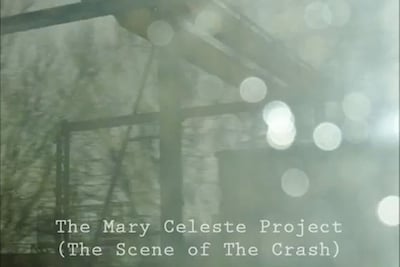Confessions of an Artist: The Mary Celeste Project (The Scene of the Crash) – Part 2
December 9, 2014
[Image: John Ledger. From The Mary Celeste Project (The Scene of the Crime)]
Read Part 1 of ‘Confessions of an Artist’ by John Wright
Part 2
As I followed Ledger out of the glossy, global capitalist, simulation of the Meadowhall food court, I became aware of a change. The architectural aesthetic had shifted to the functional. I walked over the threshold of the homogenous exit door into a kind of non-place that could have been anywhere in the world. I became aware, at this point, of a buzzing and clanging sound that was emanating from multiple air-conditioning systems, service pipes and electrical points.
Outside, but still inside the Meadowhall service routes, the architecture changed but still ‘iconic’ the essence of beast, its breath no longer perfumed by the hedonistic hyper-colon of the shopping experience, becomes a vile mist that emits from the waste disposal units.
Ledger was the first to speak.
“Nothing has really changed, has it…?” He paused, as a group of shoppers bustled around our location.
“It’s just these service entries and mechanical conditioning systems could be said to be the factories, plants and metal works of the industrial revolution and beyond to Sheffield in its prime economic state.”
“Feeding the middle and upper classes of the bourgeoisie, who experience the market inside. A form of symmetry, don’t you think or perhaps a continuation hidden by the reduction in physical labour.”
I thought for a second.
“It could be said to be a microcosm of that structure. The structure itself minimised, crushed into a smaller space, made efficient to speed up the process of capitalism.” I said, as Ledger was nodding.
We walked along the path that that circles between Meadowhall (The Shopping centre) and the river Don.
“Do you think that we could experience Meadowhall in a different way?” I uttered, as I raised my arms up and snapped a photograph of the service bridge that we had stopped at.
“By this, I am thinking that, in the here and now could we take a tour of this structure, this environment. To subvert Meadowhall into an alternative gallery space by still ‘experiencing’ the hyper real but shifting away from the act of exchanging money for goods.” Ledger put his camera down.
“That’s interesting, so you are suggesting that we engage in a different form of commerce with the very space that is designed for ultimate capitalism. I can see the potential; much like window shopping only ‘buying’ into the visceral experience and not leaving the monetary trace that is the general purpose of the institution itself.”
“How could we carry out such an act, what would the method be.” I said.
“How about, as you stated, a ‘tour’ of the service routes and architecture?”
“Maybe the car parking area would also be incredibly fruitful, we could document it through photography and discussion, just as we are undertaking currently.” As we walked around towards the car parking area, I realised that Meadowhall was in fact surrounded by a sea of car parking that wrapped its way around the site. The ratio of shopping centre to car park (if indeed they can be separated) must be at least 50:50.
“You know man, the car park is becoming just as in focus, architecturally, as specific buildings such as living spaces and offices. The car is so central to our society and culture that when a project is commissioned if it doesn’t have a car park involved it can potentially take longer to receive planning permission.”
“That’s ridiculous.”
“I know!”
“The experience of Meadowhall, is considerably altered, by exploring the car park. The structure and form of the car park is functional and it specifically channels the public to one goal that is to park and quickly move into the shopping experience. The method that we are now employing is often hindered by ‘no go areas’, bollards, awkward railings and cars themselves.”
“Yes, you have it right in that observation; it’s as if we are prevented from carrying out this task because we are not using the car park in the prescribed way.” I nodded my head with a smile on my face.
“These areas are boundaries (deconstructive figures) both inside and outside of the superstructure. They are unrealised and realised in the sense of how they function, but become something specific when viewed as an object in their own right.”
“Ok, so you are saying that our actions here are beginning to change the meaning of the space we are currently walking through. I can sort of see that, but I think that there maybe some aspects of the structures and norms here that we cannot alter.”
We walked into a part of the service bay that was a ‘no go area’ for the public. We quickly took some photographs, as a security guard was looking slightly alarmed at the situation. I hoped back over the chain, that designated the area, ledger followed.
“It’s like a prison!” I said. Walking up a car ramp to get to the top level away from prying eyes. Ledger stopped. I turned. He had a puzzled look on his face.
“Was it going to be a prison, at some time.”
“Rings a bell, actually.” I said.
“It certainly, is a kind of prison, a capitalisist drug, of the now. It engineers people to come back to a place on a constant basis.” We had reached the plateaux, and could survey the seen from the top story of the car park.
“Is it againt their will though, which they come.” I was sure that freedom had a role to play in the definition of a prison.
“Is addiction?”
“I suppose, addiction is a mental and physical illness
John Wright
Filed under: Art & Photography
Tagged with: confessions of an artist

Comments